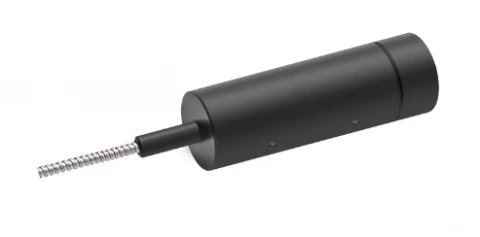2000nm Fiber to Free Space High Power Isolator for Pulse Application
Description
Designed for high precision and reliability, the 2 μm Fiber to Free Space High Power Isolator is an essential component for fiber laser systems and advanced instrumentation requiring high power management. This isolator excels in minimizing optical losses with a remarkably low insertion loss, while providing superior isolation to protect against feedback that can degrade system performance.
The device is optimized for a center wavelength of 2000 nm, making it particularly suitable for mid-infrared applications. It boasts an excellent extinction ratio (20 dB for PM types), ensuring effective polarization maintenance where required. Additionally, the isolator handles up to 5 watts of average optical power and can manage peak powers for nanosecond pulses up to 10 kW, accommodating a wide range of intensive laser operations.
With a high return loss of 45 dB, the isolator enhances overall system efficiency by preventing the re-entry of signals into the laser source. Its design is built to withstand diverse environmental conditions, operating reliably across a temperature range from 10°C to 60°C, ensuring stability and durability in varied operational contexts.
2000nm Fiber to Free Space High Power Isolator for Pulse Application
Specifications |
|
|---|---|
| Type Of The Device: | Isolator |
| Operating Wavelength: | 2000 nm |
| Max Power: | 5 W |
| Min Isolation: | 35 dB |
| Center Wavelength (λc): | 2000 nm |
| Operating Wavelength Range: | λc ± 30 nm |
| Output Beam Diameter: | 4.9 ± 0.5 mm |
| Extinction Ratio (PM Type Only, Both Axes Are Working): | 20 dB |
| Min. Isolation @ λc, 25 ℃: | 35 dB |
| Max. Average Optical Power: | 5 W |
| Max. Peak Power For Ns Pulse: | 10 kW |
Features
- Low Insertion Loss (0.5 dB): Ensures minimal power loss during transmission, crucial for maintaining efficiency in high-power laser systems.
- High Isolation (35 dB): Offers robust isolation to protect against feedback and signal degradation, essential for stable laser operation.
- High Return Loss (45 dB): Minimizes signal leakage back into the laser source, enhancing the overall system performance.
- High Power Handling: Capable of managing up to 5 watts of average optical power and peak powers up to 10 kW for nanosecond pulses, suitable for various high-power applications.
- Excellent Extinction Ratio (20 dB for PM type): Provides effective polarization maintenance, critical for applications requiring precise polarization control.
- Environmental Stability and Reliability: Operates effectively within a wide temperature range (10°C to 60°C), ensuring performance stability under varying environmental conditions.
- Customizable Configuration: Offers options for fiber type, fiber jacket, and fiber length, allowing adaptation to specific system requirements.
Applications
- Mid-Infrared Fiber Lasers: Ideal for systems operating at around 2 μm wavelength, commonly used in materials processing, medical surgeries, and scientific research.
- Telecommunications: Enhances the performance of communication systems that utilize mid-infrared wavelengths for specialized data transmission, where high isolation and low insertion loss are crucial.
- Medical Instrumentation: Supports medical laser systems used in diagnostics and surgical procedures, where precise laser control and stability are necessary for effective treatments.
- Scientific Research: Provides a reliable component for experiments involving mid-infrared lasers in fields such as spectroscopy, where consistent laser output and polarization control are essential.
- Industrial Processing: Used in laser systems for cutting, engraving, and other manufacturing processes that require lasers at the 2 μm wavelength, benefiting from the isolator’s high power handling and stability.
- Military and Defense: Integral in military applications where mid-infrared lasers are used for targeting, range-finding, and other tactical systems, requiring robust environmental stability and reliable performance.
For pricing, technical or any other questions please contact the supplier
- No registration required
- No markups, no fees
- Direct contact with supplier
-
Ships from:
China
-
Sold by:
-
On FindLight:
since 2024
Frequently Asked Questions
The 2 μm Fiber to Free Space High Power Isolator is a device designed to minimize optical feedback and maximize signal integrity in laser systems operating around a 2000 nm wavelength. It features low insertion loss, high isolation, and is suited for fiber laser and instrumentation applications.
It enhances fiber laser systems by providing low insertion loss and high isolation, which are crucial for maintaining the efficiency and stability of the laser output, particularly in systems that operate at mid-infrared wavelengths.
High isolation is critical as it prevents back reflections into the laser source, which can cause destabilization and damage. This is especially important in high-power applications where maintaining laser quality and safety is paramount.
Yes, the isolator is capable of handling up to 5 watts of average optical power and peak powers up to 10 kW for nanosecond pulses, making it suitable for a range of demanding laser operations.
Key features include low insertion loss of 0.5 dB, high isolation of 35 dB, a return loss of 45 dB, excellent environmental stability, and the ability to handle significant optical power. It also offers customization options for specific application needs.
It is typically used in mid-infrared fiber lasers for industrial processing, telecommunications, medical instrumentation, scientific research, and military applications where precise control over laser characteristics is crucial.
High return loss means that the isolator effectively prevents signals from leaking back to the laser source, which enhances the efficiency and safety of the system by reducing potential interference and damage.
The isolator’s capability to operate within a temperature range of 10°C to 60°C ensures reliable performance under varying environmental conditions, essential for applications in fields such as medical technology and military systems where operational reliability is critical.
The isolator offers various customization options including fiber jacket type, fiber length, and specific requirements for polarization-maintaining or non-polarization-maintaining types, allowing for tailored solutions to meet different system requirements.
